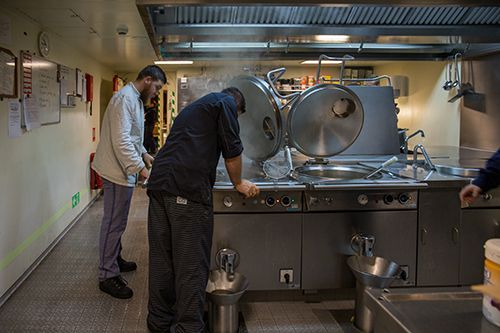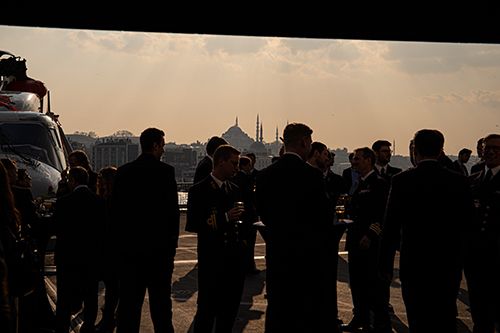After almost a month, the Air Defense and Command frigate Hr.Ms. Trump left the Red Sea again. As planned, the frigate continues its world voyage further east. Trump did not deploy any weapons in the Red Sea. However, the ship had to go to the highest state of readiness once: ‘combat watch’, the ship’s commander said in an interview with Marineschips.nl.
Zr.Ms. Tromp with the German frigate FGS Hessen in the Red Sea in the background. Both ships have left the sea area. The Hessians have returned to Germany. De Tromp sails on. From the Netherlands, the logistics support ship Zr.Ms. Karel Doorman already on his way to the Red Sea. (Photo: Defense)
Zr.Ms. Tromp is currently sailing in the Arabian Sea and this afternoon Marineschips.nl had a telephone interview with the ship’s commander, naval captain Yvonne van Beusekom. “We are on our way to Mumbai,” Van Beusekom explains.
There is no stopover planned and so the crew will only set foot again in India. A long time at sea. “You can say that,” Van Beusekom responds. The previous port was Crete, just over a month ago today. “And we still have some miles to go before we reach Mumbai. We have loaded oil from American tankers along the way, but it is now time for a port to recover and load refreshments.”
Intensive
Zr.Ms. Tromp did not have to repel an attack in the Red Sea and therefore did not deploy any weapons, the ship’s commander also confirms. Nevertheless, it was an intensive period. Van Beusekom looks back on it positively: “Once in the Red Sea, we started to adapt to the environment. With the high seawater temperatures there you are really putting the ship to the test. Because you have to ensure that all systems remain properly cooled. Radars are especially sensitive to this. But it went well beyond expectations.”
KLTZ Yvonne van Beusekom in the command center of Zr.Ms. Tromp, last year during Formidable Shield. (Photo: Defense)
Radar deployed to maximum effect
“We have operated mainly in the southern part of the Red Sea, where you know a ballistic missile could be launched at any moment. And we have seen that we can deploy the ship as intended.”
“That may seem very easy: you turn the button and then the radar is on. But that is not the case. You have to get used to the environment step by step. That was also the advice of the colleagues who came before us: ” don’t immediately sail into the most dangerous area, make sure you are well prepared’. We already were that way through that training. Then we started building it up, so that you really know what you are looking at and what is happening around you. “
The deployment of the Tromp was also the first time that the new SMART-L MM/N radar was deployed in a conflict area. “We did Formidable Shield with De Tromp last year,” says Van Beusekom. “There the radar was also used to the limit and had to detect home-made target drones, but now we were indeed in an environment where you do not know in advance what kind of threat you will face.”
The radar met expectations, says Van Beusekom. “We have fully deployed the capabilities of the radar. In peace conditions you are often limited because you do not want to reveal everything from the radar or because you want to achieve limited transmission power when sailing near land. Now we have fully deployed the radar. And then you see the difference. Right down to the birds that migrate through the Red Sea. And that is also what I just meant: you have to know what is happening in the area, so that you do not see birds as a threat.”
Van Beusekom emphasizes that it is not just about the radars that need to be deployed to their maximum potential. “You always have to make sure that all your systems are ready. Weapons, sensors and also the propulsion.”
Combat guard on post
Defense.nl reported yesterday that Tromp had also detected attacks. “I cannot tell you in detail what we saw,” says Van Beusekom, “because that also says something about what our radar capabilities are. But you see what is flying, you can observe detection distances, you see what other units are doing, so you have an idea of what’s happening. The Houthis are also trying things out; it’s not like everything is an attack right away.”
Navy ships sail in sea watch during peacetime; if there is a threat, war watch can be chosen. In such a situation, half the crew is normally on duty. During battle watch, everyone is on duty and the ship is ready to go into battle. Once again the alarm sounded. “We made observations on the radar,” Van Beusekom explains. That was close enough for us to decide to go to battle watch as there was a chance there was more to come or it was getting closer. That wasn’t the case in the end.”
It is special that a Dutch naval ship goes on combat watch outside an exercise. The last time that happened in a comparable situation was in the 1990s during the Yugoslav war. For de Tromp the drill not new in itself. “We had practiced this a lot. We were completely prepared for it, then we just see what the situation is like and when it is calm, you can wind down again. It actually went very well.”
So there was clearly a build-up for the crew. Van Beusekom: “The moment you enter the Red Sea, you have a bit of tension. You don’t know exactly what to expect yet. You build it up step by step and at a certain point you get closer to the threat area. In the meantime, you become more comfortable with what you see. When you actually go to combat watch, it feels very familiar: you have trained it, you know the environment, you know what the sensors can do and what the warning time is. you know why you are doing it and then it is just very controlled and controlled.”

The galley of an LCF in archive image. (Photo: Jaime Karremann/ Marineschips.nl)
Simple food
It is not self-evident that a ship with 200 people on board can switch to combat watch so quickly. Van Beusekom: “When you start training, it takes three-quarters of an hour before the ship is completely ready. Partly because you have to shut down systems so that you incur as little damage as possible. Now we had adjusted our business operations. For example, we no longer washed and became sober. We did this because when the button for the alarm signal is pressed, it is a matter of taking a pan off the heat, pulling out a few plugs and then Are you ready for a possible impact? Because that is what those precautions are intended for.”
“Combat guard, that’s what we train. But we often train it briefly in exercises. That’s all labor-intensive. Now it was in an actual threat environment for a long time and then you experience what that’s like. Then it becomes apparent, for example, how boring it sometimes is because sometimes there’s nothing happens, but you can’t go outside – just to name a few – because of possible weapons deployment or radar transmissions. In that respect, it was really restrictive in those main threat areas.”
Opportunistic
Although there was a continuous threat, it appears that the Houthi rebels in Yemen are less actively attacking ships. “There were earlier too ups and downs“, says Van Beusekom. “But indeed the activity is not as high now as in the previous months. We don’t know exactly why, it could have several causes. The fact is that the Houthis participated in the attack on Israel. On the other hand, there have been a number of significant attacks on ships. Fortunately, those ships were escorted, but it all seems very opportunistic. They just shoot. They work with a certain vision, but they still remain very unpredictable.”

A reception on the helideck of an LCF. (Photo: Jaime Karremann/ Marineschips.nl)
Royal day
The Red Sea is behind us, the South China Sea is still many miles away. Time to relax? Van Beusekom laughs. “Yes and no. We have to go to Mumbai first. India is very important for the Netherlands and we mainly have a diplomatic role there. This means that for most of the crew they can relax, but we are also organizing a big reception for King’s Day. “
“We will then head enroute to the South China Sea and those preparations are already starting, because it is a special maritime area where we have to be on our guard. Although there is a different threat picture than in the Red Sea, but shipping is also being restricted there.” threatened.”![]()
 | Author: Jaime Karremann Jaime is the founder of Marineschappen.nl and has written more than 1,500 articles on various naval topics. In 2017, he published his non-fiction book In the utmost secrecy out and later a submarine thriller Orca. Before Jaime started working on this site full-time, he worked in the Navy for over 12 years, most of which in a civilian position. Jaime studied Communications in Groningen. |
Please enable JavaScript to view the comments powered by Disqus.
comments powered by











